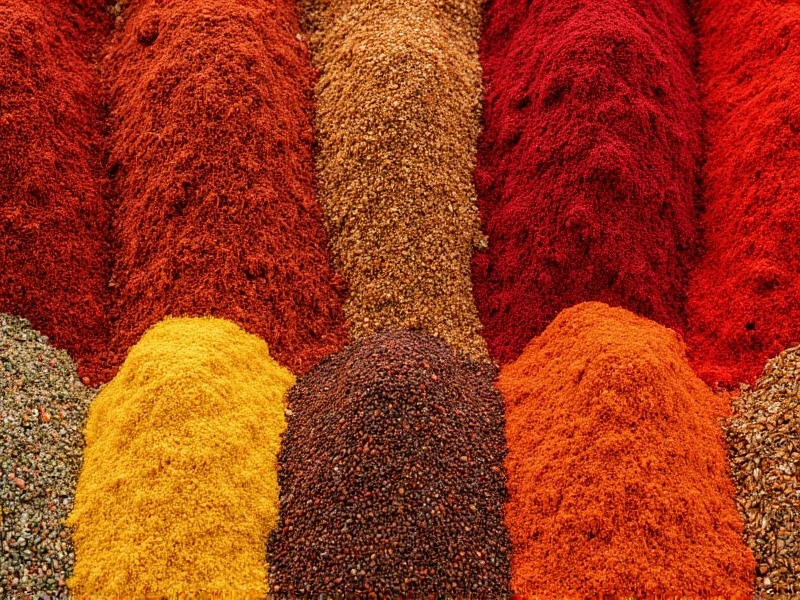The most common spicy spices names include chili peppers (such as cayenne, habanero, and jalapeño), black pepper, ginger, horseradish, wasabi, mustard seeds, and Sichuan peppercorns. These spices create heat through different chemical compounds—primarily capsaicin in chili peppers, piperine in black pepper, and allyl isothiocyanate in wasabi and horseradish. Understanding their unique heat profiles and flavor characteristics is essential for effective culinary application.
Spicy spices have shaped global cuisines for centuries, adding both heat and complex flavor dimensions to dishes. While many people equate “spicy” solely with chili peppers, numerous other spices deliver distinctive heat sensations through different biochemical mechanisms. This comprehensive guide explores the science behind spiciness, catalogs the most significant spicy spices by heat intensity and flavor profile, and provides practical guidance for incorporating them into your cooking.
The Science Behind Spicy Sensations
Spiciness isn't technically a taste but a pain response triggered by specific compounds activating TRPV1 receptors in our mouths. Capsaicin, found in chili peppers, creates the familiar burning sensation measured on the Scoville scale. Piperine in black pepper produces a sharper, more immediate heat. Meanwhile, wasabi and horseradish contain allyl isothiocyanate, which stimulates nasal passages more than the tongue, creating that distinctive sinus-clearing effect. Sichuan peppercorns contain hydroxy-alpha sanshool, which creates a unique tingling or numbing sensation rather than conventional heat.
Comprehensive Guide to Spicy Spices Names and Characteristics
Understanding the differences between various spicy spices goes beyond mere heat measurement. Each brings distinctive flavor notes, optimal usage methods, and cultural culinary traditions.
| Spice Name | Heat Compound | Scoville Units (Approx.) | Flavor Profile | Best Culinary Uses |
|---|---|---|---|---|
| Cayenne Pepper | Capsaicin | 30,000-50,000 | Sharp, earthy, slightly fruity | Curries, Cajun dishes, hot sauces |
| Habanero | Capsaicin | 100,000-350,000 | Tropical fruit notes, floral | Salsas, Caribbean cuisine, hot sauces |
| Black Pepper | Piperine | 100-500 | Woody, piney, complex | Universal seasoning, meat rubs, sauces |
| Ginger | Gingerols | N/A (not capsaicin-based) | Warm, citrusy, slightly sweet | Asian cuisine, baked goods, teas |
| Wasabi | Allyl isothiocyanate | N/A (different mechanism) | Sharp, clean, sinus-clearing | Sushi accompaniment, dressings, dips |
| Sichuan Peppercorns | Hydroxy-alpha sanshool | N/A (numbing sensation) | Citrusy, floral, tingling | Chinese cuisine,麻辣 (mala) dishes |
Chili Peppers: The Most Diverse Spicy Spices
Chili peppers represent the most varied category among spicy spices names, with thousands of cultivars differing in heat, flavor, and appearance. The Capsicum genus includes five primary domesticated species, each with distinctive characteristics. From the mild poblano (1,000-2,000 SHU) to the extreme Carolina Reaper (1,400,000-2,200,000 SHU), chili peppers offer an extraordinary range of heat intensities. Regional varieties like the Thai bird's eye chili, Mexican serrano, or Indian bhut jolokia each contribute unique flavor dimensions beyond mere heat. When working with fresh chilies, remember that seeds and white membranes contain the highest concentration of capsaicin, while the flesh provides more of the characteristic flavor.
Non-Chili Spicy Ingredients Worth Knowing
While chili peppers dominate discussions of spicy spices names, several non-chili ingredients deliver distinctive heat experiences. Black pepper, often overlooked as merely “seasoning,” contains piperine which creates a different sensation than capsaicin—more immediate but shorter-lasting. Ginger's gingerols produce a warming sensation that builds gradually. Wasabi and horseradish work through volatile compounds that affect nasal passages more than taste buds. Sichuan peppercorns (actually berries from the prickly ash tree) create a unique tingling or numbing effect through sanshools, often described as “electric.” These ingredients demonstrate that “spicy” encompasses multiple sensory experiences beyond simple heat.
Practical Applications in Cooking
Understanding how different spicy spices behave in cooking is crucial for successful implementation. Capsaicin is fat-soluble and alcohol-soluble but not water-soluble, which explains why dairy products or alcoholic beverages better alleviate chili heat than water. Heat from black pepper diminishes with prolonged cooking, while chili heat remains relatively stable. Wasabi and horseradish lose potency quickly when exposed to air, making fresh preparation essential. Sichuan peppercorns benefit from dry-toasting to enhance their citrus notes. When developing recipes with spicy spices names, consider adding heat gradually and allowing time for flavors to meld, as capsaicin perception can intensify over time.
Safety and Handling Considerations
Working with extremely spicy ingredients requires proper handling techniques. Always wear gloves when preparing super-hot chilies like ghost peppers or Carolina Reapers, and avoid touching your face. Cut chilies on a dedicated cutting board that won't transfer oils to other foods. If you experience chili burn on your skin, use oil or dairy products rather than water to remove capsaicin. For nasal irritation from wasabi or horseradish, breathing through your mouth can provide temporary relief. Remember that cooking spicy foods in enclosed spaces can create airborne capsaicin that irritates eyes and respiratory passages—ensure proper ventilation.
Developing Your Palate for Spicy Flavors
Building tolerance to spicy spices names isn't just about enduring heat—it's about developing the ability to discern subtle flavor differences beneath the burn. Start with milder spices like black pepper or mild paprika, then gradually introduce medium-heat options like cayenne before progressing to hotter varieties. Pair spicy foods with cooling elements like yogurt, coconut milk, or avocado to balance the experience. Notice how different types of heat affect your palate—the immediate sharpness of black pepper versus the building warmth of ginger versus the delayed burn of habaneros. This mindful approach transforms spice from a mere sensation into a sophisticated culinary tool.











 浙公网安备
33010002000092号
浙公网安备
33010002000092号 浙B2-20120091-4
浙B2-20120091-4